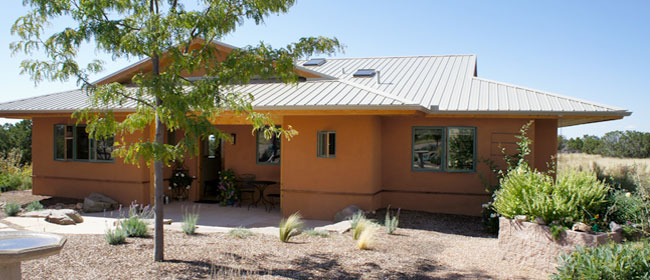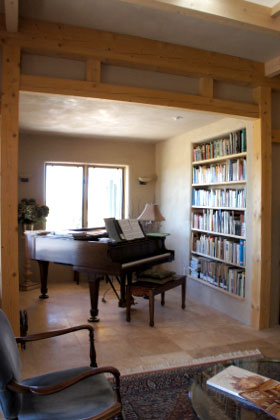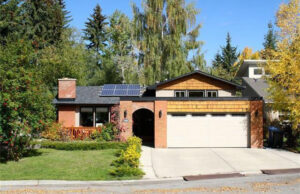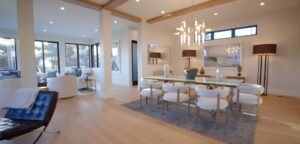Santa Fe is counted as America’s oldest capital city and has an abundance of adobe-styled homes and businesses. These buildings are distinctive, historical representations, that blend Spanish, Native American and other local cultures and are made by combining sand, clay, water and other fibres like sticks or straw.
The look combines design elements of Pueblo and Pueblo-influenced Spanish adobe construction with modern material building methods. This design is inspired by the early 20th century Santa Fe architects John Gaw Meem and Carlos Vierra and includes Spanish Pueblo Revival Architecture.
Santa Fe is clean and beautiful and the adobe look makes for a nostalgic atmosphere. The city has great shopping and several good restaurants.
Nature trails comprise over 325 acres and rise through 4 eco-zones with over 140 species of birds, making the area a mecca for hikers and birdwatchers.
A tour highlight is a visit to the 131 year old Lorreto Chapel, known for its unique spiral staircase. This staircase, built by an unknown carpenter, shows two – 360 degree turns, was built with no nails or screws and reportedly one piece of wood lines the bottom layer of the spiral.
As well as being America’s oldest city, Santa Fe also boasts having the nations oldest home as well as church. The house was built in 1612 and its alley neighbour, the San Miguel Mission, somewhere between 1600 and 1646, with parts dating to 1100.
Don and Michele’s EcoNest®
Don and Michele – originally from Chicago – wanted to live in an environmentally friendly, natural type of home. When a cousin sent a newspaper clipping about a EcoNest® built outside of Portland, the couple had to take a look. When they toured the home they thought “Wow, this is fabulous. This is the home we want to build”.
They next attended an EcoNest workshop in Santa Fe and were further impressed with these unique homes.
They loved the adobe look of these straw bale/cob type homes, that they used natural materials and that care was taken to use non-toxic finishes.
EcoNest® says the home is where health, ecology and sustainability begin.
The natural building materials in these homes can last for centuries as they are protected from the elements by three to five foot overhangs. These homes usually have a stone base so they are protected from the ground up as well.
An EcoNest has high thermal mass and the straw/clay mixture works well for both hot and cool temperatures. EcoNests have been built in such diverse climates as Iowa, Wisconsin, New Mexico and Colorado.
EcoNest® says:
The EcoNests utilize several natural climate control design features to help reduce the need for mechanical heating and cooling. Shading roof overhangs, cross ventilation in each room, earth coupled flooring and massive adobe internal walls help keep the homes comfortably cool in the summer. Technically the clay/straw walls themselves provide an R-24 insulation value. We have experienced them to perform at a much higher rate than a frame wall of the same R value would. This is due to the uninterrupted monolithic wall plane and the mass provided by the clay, which helps store heat.
Excited to build their own EcoNest, Don and Michele came back to Chicago and proceeded to make a list of the areas they found desirable and would like to live. The final decision was Santa Fe. When they returned to the area they were delighted to find a fantastic view property – almost immediately.
It was also helpful that the EcoNest company had already built homes in the state, so they didn’t have to deal with the local building codes, or train carpenters and other contractors. Don says the building is kind of revolutionary and sometimes building inspectors need to be educated. Fortunately in Santa Fe they already understand the distinctive properties of the EcoNest.
An EcoNest draws inspiration from the Santa Fe style, and the adobe look fits perfectly in these hills. Don and Michele’s home faces south and the passive solar and high thermal mass properties help to heat and cool the home.
Don and Michele like that the home has lots of windows, something you typically don’t see in a straw bale/cob type house. They also like the timberframe details though their home is not strictly timberframe beyond the core. The home also uses a Larsen Truss type system that has been specially designed to mesh with the building materials.
Bamboo helps to strengthen the walls and is used instead of a metal rebar in the frame. These rods go crossways and have the same tensile strength as steel – and they are environmentally friendly.
Don and Michele’s home started from a framed structure, specially manufactured to contain a clay-straw matrix. The straw portion insulates and the clay gives the home its thermal properties. Our couple used an oat straw, local to the area.
The first layer is framed, stuffed, formed and then tamped, followed by a second layer of the same, noting that the specially designed frame gets removed and then moved to next layer. This gets repeated until the walls are finished, usually taking about three and a half layers to get to the top.
Next, the walls need time to dry and this can take up to three months. As time goes by, the straw inside the walls starts to sprout. They are pronounced dry when the sprouts die due to a lack of moisture. It is then time to plaster.
Don and Michele found a local plasterer who did an exceptional job finishing their interior and exterior walls. The natural adobe-influenced walls have a wonderful patina and were a perfect complement to the timberframe core of the home. They have a soft and beautiful texture and are finished with Loma, one of three finishes by American Clay.
Don says:
We wanted everything be very quiet and very serene, even though we love all the colored plasters and we love the New Mexico look, it just wasn’t for this house.
The bungalow home was open and inviting as well as brightly lit from several windows. A unique rice paper mandala covers the open space under the roof in the central living space, muting the light from 4 rooftop skylights, yet let in light so no electrical was needed during the day.
As per the EcoNest philosophy, the couple used only natural materials, choosing only Low VOC and equivalent.
Don and Michele didn’t want to use fossil fuels and therefore installed Solar Thermal for heating and domestic hot water. An electric boiler, fueled by their Solar Photovoltaic (PV) array, provides backup for those days when the sun is absent.
The couple has always been wary of their energy use and have never been big energy consumers. They don’t use a microwave or have an extra freezer. They never even wanted a dishwasher as they enjoy doing the dishes together while catching up on their day.
Their PV is a grid-tied and mounted on a Solar Tracker. The system provides the majority of their electric power. In New Mexico, homeowners can sell the “renewable energy credits” for an amount over the electricity rate through to 2018. The utility company then can apply these credits towards meeting its obligations under New Mexico’s Renewable Energy Standard, which requires utilities to provide 10% of the power from renewable sources by 2011.
In addition, Don and Michele are also eligible to receive up to 30% of the cost of their PV from the New Mexico government. There are additional incentives and if the program continues as promised, the total combined incentives will almost equal the cost of the system – over 25 years – helping to make their Solar PV a break even investment.
The government of New Mexico benefits from people such as Don and Michele. The couple lives almost net zero, putting more electricity onto the grid than they use for as much as ten months of the year. This in turn increases local power generation, decreasing the load to the grid and extends the life of transformers and other grid components, avoiding and delaying further upgrades to the grid system.
An EcoNest is a well thought out, well insulated home that uses natural as well as healthy materials. Using renewable energy Don and Michele are leading by example and using very little of the earths resources. Their home is well put together and quite beautiful. Visiting Don and Michele was one of the highlights of our 2 month tour.
There is a book called EcoNest: Creating Sustainable Sanctuaries of Clay, Straw, and Timber By Paula Baker-Laporte and Robert Laporte, Gibbs Smith. Your ECO Friend Terry as well as friends Don and Michelle have the book in their library.













Very wonderful blog post. I located your web page and wished to mention that I’ve genuinely liked reading your blog articles.
don’t even know how I ended up here, but I thought this post was good. I do not know who you are but definitely you’re going to a famous blogger if you are not already Cheers!
Thanks.
Very nicely put together post with many superb tips. I must say, extremely well done and the very best in future posts
awesome article! with no beating around the bush, i like when people are straight to the point.
As soon as I observed this internet site I went on reddit to share some of the love with them.
Glad to help.
Terry
Thank You
Thanks on your marvelous posting! I quite enjoyed reading it, you may be a great author.I will always bookmark your blog and definitely will come back in the future. I want to encourage that you continue your great job, have a nice holiday weekend!
I would say it can be my extremely 1st time viewing your web site. I can undoubtedly write that it contains a great number of helpful points. Excellent website. I just finished mine and i was looking for some ideas and you gave me a couple of. Great read!
Thanks
Thank you, I have more tours to post. It just takes a long time to transcript the interviews for the posts.
Terry
I do a lot of my own graphics. Other than that I have a WordPress.org site done on a Genesis Platform. Check out the link in my sidebar… Here is a link to Genesis
I was reading through some of your content on this site and I think this internet site is really instructive! Keep on posting.
Sup. Just want to leave a short statement and inquire exactly where you got your weblog graphics I might be starting on own web page and absolutely really like your design.
You make a great point. Got some great info here. I think that if more people thought about it that way, they’d have a better time get the hang ofing the issue.
Just using the RSS works. Remember that you share posts you like.
Terry
Good site! I truly love how it is easy on my eyes and the data are well written. I am wondering how I could be notified when a new post has been made. I have subscribed to your RSS which must do the trick! Have a nice day! “If you are going to do something wrong at least enjoy it.” by Leo C. Rosten.
Excellent post. Very interesting are the revolutionaty advancements being made. It is definitely the way of the future and the sooner, the better.